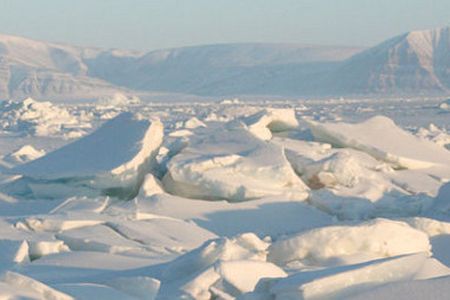Arctic Sea Ice Leaves Record-Small Footprint

(ISNS) -- Arctic sea ice has never looked so thin. In the past decade, melting has sped up, shrinking the area where ice floats above the Arctic Ocean to fractions of its previous size and leaving chunks of frozen seawater uncomfortably slender. Recent research confirmed that the extent of Arctic sea ice in September 2012 was the smallest on record.
Thick slabs of sea ice built up over time -- called multiyear ice – were once a more common sight. Only decades ago, it covered up to 60 percent of the Arctic, according to the National Snow and Ice Data Center (NSIDC), in Boulder, Co. Now, due to a warming climate, much of that multiyear ice has thawed, leaving about 30 percent of the Arctic Ocean shielded by this old ice at the end of this past summer.
Robust multiyear ice has been largely replaced by first-year sea ice, which comes from seawater that freezes over a single winter. Like ice cubes removed from the freezer before fully solidifying, delicate pieces of first-year ice can quickly disappear in warming waters.
This March, 71 percent of the Artic sea ice was made up of first-year ice – narrowly missing the record for the most first-year ice at 72 percent in March 2008, said Julienne Stroeve, an NSIDC research scientist. The loss of stable multiyear ice may have dramatic effects on ocean life and the global climate.
The area covered by sea ice covers naturally shrinks and grows with the seasons. New ice is made from seawater in the cold winter, and stretches out to its maximum size in late February or early March. Warm summers liquefy some of the sea ice and the vast white slabs dwindle to their smallest area -- or minimum extent -- around September.
"The multiyear ice actually makes up most of the ice during [the] ice minimum," said Joey Comiso, senior scientist at NASA Goddard Space Flight Center. With multiyear ice disappearing, the sea ice's footprint in both summer and winter is getting smaller.
For over 30 years, scientists have documented a decline in the total area covered by all forms of Arctic sea ice. In September 2012, that extent shrunk to 1.32 million square miles, the smallest area recorded in the Arctic since scientists began collecting the data in 1979, according to NSIDC.
Sign up for the Live Science daily newsletter now
Get the world’s most fascinating discoveries delivered straight to your inbox.
As the Arctic climate has warmed, much of the vast, thick slabs of multiyear ice have turned to slush and dripped back into the ocean. About 75 percent of total Arctic sea ice, both first-year and multiyear ice, has disappeared since the late 1970s, said Jennifer Francis, a research scientist at Rutgers University.
Sea ice acts as a giant mirror, bouncing much of the sun's rays back into space. As the sea ice vanishes, more of the sun's heat is absorbed by the ocean.
A warmer ocean can melt more sea ice – it's a feedback loop that scientists call the albedo effect.
Thin ice may warm the Arctic Ocean in additional ways. Recently, a study by scientists at Germany's Alfred Wegener Institute for Polar and Marine Research, published online in the journal Geophysical Research Letters , showed that almost three times more light could zip through thin ice than multiyear ice and potentially heat the water below.
"The Arctic is warming two to three times faster than the rest of the northern hemisphere and the globe as a whole," said Francis.
With the oceans heating up, the melt seasons are getting longer and the winter freezing seasons shorter. As a result, more ice has melted in recent summers, said Stroeve.
Melting sea ice can also dramatically change the Arctic ecosystem for the plants and animals that depend on it. The changes can also reroute ocean currents and alter weather in different parts of the globe.
"Because the artic is warming so fast, it's having this effect on the jet stream that makes it wavier," said Francis. Southbound parts of this wave drag more cold air down from the Arctic while northbound parts of the wave swoop up warmer air.
While the trends suggest that the sea ice will continue to get thinner and its expanse smaller, the arrangement of sea ice can look different each year.
Weather events, such as wind, storms, and clouds can influence how much ice may be lost or gained each season.
Scientists aren't certain how long it may be before all of the Arctic sea ice disappears in the summer months. But most scientists "think it's going to be in the next two to three decades," said Stroeve.
Ryder Diaz is a science writer based in Santa Cruz, Calif.
Inside Science News Service is supported by the American Institute of Physics.












